New wave of demolitions in West Bank: Another phase in policy of expelling Palestinians from vast portions of West Bank
Published:
16 Feb 2016
As of January 2016 Israeli authorities have stepped up efforts to expel Palestinian communities from vast areas in the West Bank, with a focus on the South Hebron Hills, the area around the settlement of Ma’ale Adumim, and the Jordan Valley.
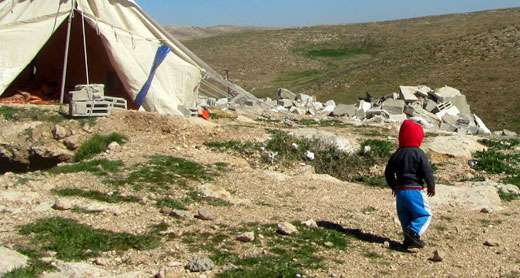 Toddler against background of ruins in Khirbet al-Halawah, Masafer Yatta. Photo by Hagai El-Ad, B’Tselem, 4 Feb. 2016
Toddler against background of ruins in Khirbet al-Halawah, Masafer Yatta. Photo by Hagai El-Ad, B’Tselem, 4 Feb. 2016
As part of these efforts, as of January 2016 and through 11 February, authorities have demolished 73 dwellings and 51 other structures, leaving 284 people, including 161 minors, without shelter. In many communities these were repeat demolitions of structures that were previously demolished, sometimes just days earlier, or cases in which authorities confiscated or dismantled replacement dwelling tents provided to the families as humanitarian aid. At least 37 of the structures demolished since the beginning of the year had been donated by aid agencies and European countries.
This exceptionally large-scale demolition campaign is reminiscent of the one waged in August 2015, when the authorities demolished 101 structures, including 50 dwellings, and left 228 people, 124 of them minors, without a roof over their heads.
Some of the communities where authorities recently demolished homes have been involved in a lengthy legal battle in Israel’s High Court of Justice (HCJ). The legal proceedings have revealed the state’s premise that the residents have no right to live in their homes and communities, and the state’s position that it has no obligation to provide them with alternative housing. Even in cases in which the proceedings have been going on for years – sometimes due to negotiations or mediation between the parties – state representatives refuse to acknowledge the changes that arise from natural population growth and the communities’ changing needs. Any new construction is met with an immediate threat of demolition, and sometimes actual demolition.
This state policy ignores the impossible reality it leads to for these Palestinian residents, as if Israeli authorities have nothing do to with bringing it about: In the absence of any possibility to build legally, residents have no choice but to build their homes without permits and live in constant fear of their homes and livelihoods being destroyed. Effectively, the state forces people to subsist in inhuman living conditions, without basic amenities and with no hope or chance for improving the situation. The policy, systematically implemented for years, constitutes the forcible transfer of Palestinians - a protected population - inside the occupied territory, whether directly, by demolishing their homes, or indirectly, by creating an untenable reality.
Video: demolition of a structure in Khirbet Jenbah, 2 Feb. 2016. Filmed by Nasser Nasser Nawaj'ah, B'Tselem
The HCJ has rejected some residents’ petitions. In others, it has issued interim injunctions preventing the state from demolishing the homes pending a ruling. Some of these injunctions remained in effect for years, and some are still in effect. Yet, in not one of the scores of petitions filed, did the justices question the state’s fundamental presumptions or intervene in the considerations underpinning the authorities’ decision. By following this approach, the court allows the authorities to continue implementing the forcible transfer policy.
The large-scale demolitions carried out by Israel since the beginning of the year are part of its longstanding policy in Area C, an area which comprises 60% of the West Bank and remained under full Israeli control under the interim agreements, which were scheduled to expire 15 years ago. The policy is predicated on the concept that this area is primarily meant to serve Israel’s needs. Therefore, the authorities have consistently worked toward further entrenching Israel’s hold on Area C, pushing out Palestinians living in it, exploiting its natural resources for the benefit of the Israeli population, and creating a permanent reality of thriving settlements and minimal Palestinian presence.
This policy reflects de-facto Israeli annexation of Area C. Some Israeli officials also demand a formal annexation of Area C, with or without the Palestinian population, to Israel’s sovereign territory.
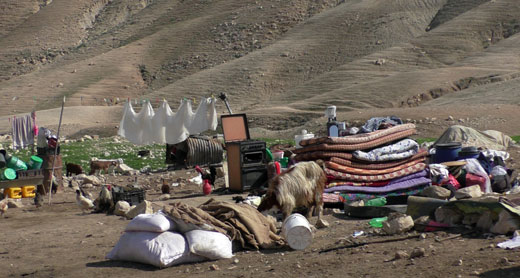
Contents of a family’s home after it was demolished, Khirbet ‘Ein al-Karzaliyah. Photo by ‘Aref Daraghmeh, B’Tselem, 10 Feb. 2016
Yet Area C cannot possibly be considered a standalone region, separate and distinct from the rest of the West Bank. The division of the West Bank into Areas A, B and C does not reflect a geographic reality. It is an administrative demarcation, set forth on a temporary basis as part of the Oslo Accords Interim Accords, more than 20 years ago. The effects of Israel’s policy are not limited to the people living in Area C. The restrictions Israel imposes there impact all Palestinians in the West Bank. They force Palestinians to live in overcrowded enclaves, without land reserves for housing, infrastructure or agriculture; affect their right to enjoy basic infrastructure such as water and roads; prevent them from receiving adequate education and health services and impact their right to travel feely throughout the West Bank. The illusion Israel has created, that it controls only Area C, is designed to allow it to evade its responsibility for the wellbeing and welfare of all residents of the occupied territory.
The partition of lands in the West Bank, coupled with the Israeli courts’ refusal to challenge the methods used by Israel to take over land - lack of outline plans, declaring areas as firing zones - methods presented to the court by the state itself, are what lies at the heart of the dispossession and control strategy Israel has been leading quite successfully in the West Bank in recent years. Despite significant international attention to this reality, to date, no effective measures have been taken to put an end to it, which effectively means the international community is greenlighting continued human rights violations and the forcible transfer of civilians inside the occupied territory.
Demolition Target Areas
Israeli authorities’ efforts to edge Palestinian communities out of Area C are focused primarily in three areas: The South Hebron Hills, the Ma’ale Adumim area and the Jordan Valley. Legal proceedings with respect to these areas have been underway for several years. Of late, there have been some significant legal developments:
In the South Hebron Hills, negotiations (regarding Khirbet Susiya) and mediation (regarding the communities of Masafer Yatta [Greater Yatta] - Firing Zone 918), between the residents and the authorities ended unsuccessfully. After no results were achieved in the negotiations conducted in the matter of Khirbet Susiya, authorities now threaten the demolition of dozens of structures in the community. In Masafer Yatta, the parties to the mediation process informed the court that the mediation had failed. The very next day, authorities resumed demolition of homes built after the petition was filed. Demolitions had been on hold ever since after the court issued an interim injunction in the urgent petitions filed by the residents. In the Ma’ale Adumim area, authorities resumed demolition in the area designated as E1. In its response to the petition filed by the local community of Abu a-Nuwar, the state said it was planning to demolish all homes in the community and expel residents to an alternate site.
The legal proceedings, even those which included mediation and negotiations, are conducted amid constant threats by the authorities to demolish buildings built while proceedings were underway. In some cases, threats were made to halt proceedings and demolish the structures that are the subject of the petition - completely ignoring the changes that have taken place in the communities’ needs over the course of the lengthy proceedings.
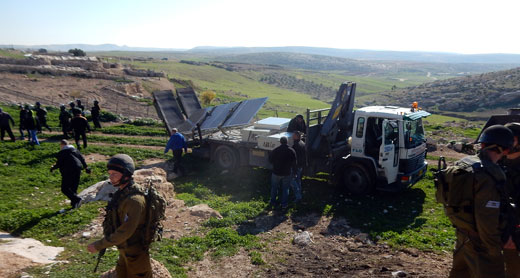 Confiscation of solar panels in Khirbet Jenbah. Photo: Nasser Nasser Nawaj'ah, B'Tselem, 2 Feb. 20166
Confiscation of solar panels in Khirbet Jenbah. Photo: Nasser Nasser Nawaj'ah, B'Tselem, 2 Feb. 20166
South Hebron Hills
Masafer Yatta: On 1 February 2016, a two-year mediation process between Israeli authorities and the 12 communities of Masafer Yatta, home to 1,300 people, ended without a resolution. These communities are located in an area Israel defined as ‘Firing Zone 918’ in the early 1980s. In 1999, authorities destroyed many structures in these communities and expelled roughly 700 residents, who were later allowed to return to their communities only with the court’s intervention. With remarkable alacrity, when notice of the end of mediation was issued, Civil Administration officials arrived at some of the communities and began photographing structures in preparation for demolition. The very next day, 2 February 2016, authorities demolished structures in two of the communities: in Khirbet Jenbah - 15 dwellings that were home to 60 people, including 32 minors; in Khirbet al-Halawah - seven dwellings that were home to 50 people, including 32 minors. Twenty of these structures had been donated by humanitarian aid agencies. In addition to demolitions, the Civil Administration and the military confiscated three solar panels in Khirbet Jenbah and two in Khirbet al-Halawah, which were also donations by a humanitarian aid agency. With no possibility of hooking up to the power grid, these solar panels were the only source of electricity for local residents. The structures demolished were built over the course of the two years that the mediation process was underway. Following urgent petitions filed by the Society of St. Yves and Rabbis for Human Rights-Israel, the HCJ issued interim injunctions temporarily halting the demolitions. With the mediation concluded, the case returns to the HCJ, which is expected to hold a hearing in March.
Khirbet Susiya: The 250 members of the community continue their fight against ongoing efforts to displace them from their land. During the 1980s and 1990s, community residents were expelled from some of their land, which the state handed over to settlers. On 21 January 2016, as part of proceedings in the residents’ petitions against the demolition of their homes, the state told the HCJ it was interested in negotiating with the residents. However, at some point, the state retracted its undertaking that so long as negotiations were underway it would not demolish structures it alleges were built after the orders halting both construction and demolition in the area were issued. This brought the state back to the position it presented in July 2015, when it announced its intention to demolish some thirty structures in the community, including homes, livestock pens, storerooms and the village clinic. These structures are home to 74 people, including 35 minors. Twenty-one of the structures the authorities seek to demolish have been donated by humanitarian aid agencies and European countries.
A day earlier, on 20 January 2016, the Civil Administration demolished two residential tents housing a family of eight, including six minors. The tents were erected in 2015, after the petition was filed, and were among the structures that the state refused to undertake not to demolish at this stage. After the demolition, a humanitarian aid organization helped the family erect two new tents, but on 4 February 2016, officials returned to Khirbet Susiya, and dismantled and confiscated the two tents.
Khirbet a-Rahwah: On 13 January 2016, the Civil Administration demolished residential tents and an animal pen in Khirbet a-Rahwah, south of the Palestinian town of a-Dhahiriyah. The structures had been home to a family of nine, including seven minors. The family’s tent had already been torn down by the Civil Administration about a year ago, and erected once more since. Civil Administration officials also confiscated a solar panel donated to the family by a humanitarian aid agency.
Ma’ale Adumim Area
Abu a-Nuwar: This community lives in an area that lies between the settlements of Ma’ale Adumim and Qedar, and has been marked by the Israeli authorities as Area E1, slated for an expansion of Ma’ale Adumim resulting in territorial contiguity between the settlement and Jerusalem. The community consists of more than 100 families, with a total population of about 600. On 6 January 2016, the authorities demolished five residential tents of families in the community. The tents were home to 28 people, including 18 minors. After the demolition, humanitarian aid agencies gave the families tents, but on 10 January 2016, the authorities returned to Abu a-Nuwar, dismantled the tents and confiscated them.
In 2015, Abu a-Nuwar residents petitioned the HCJ against the demolition orders issued for their homes, and the court issued interim injunctions. The structures demolished in January were apparently not included in the petition.
On 28 January 2016, in the proceedings held with respect to this petition, the state notified the HCJ that it had imminent plans to carry out the demolition orders and expel all residents of the community to “Jahalin West”, an alternate site located in the Abu Dis area. The state said groundwork at the site had recently been completed. The state also said in its court submission that the transfer of the Abu a-Nuwar community to the new site would serve as a test case for the feasibility of future plans to move Bedouin communities to other “permanent sites”, and its success would allow advancing these plans. This notice is the first official statement that Israel is planning to expel the entire community from its current location.
The state’s response also noted that some members of the community have, at certain times, expressed a willingness to relocate. Even if there is a kernel of truth in this claim, it is highly doubtful that any such consent was given freely, considering the circumstances the Israeli authorities impose on the residents, namely - issuing demolition orders, threatening all structures in the community, preventing connections to the water and electric infrastructure, and severely restricting residents’ ability to make a living by restricting their access to grazing pastures.
Badu al-Baba community: Badu al-Baba community: On 21 January 2016, authorities demolished three residential structures in the community. Badu al-Babais is also located in E1 and its is not far from al-‘Eizariyah, south-east of Jerusalem. The structures were home to three families, numbering 14 people, including six minors. Two of the demolished structures were pre-fab homes donated by a humanitarian aid agency.
Jericho and the Jordan Valley
A large part of the current wave of demolitions took place in the Jericho area and the Jordan Valley. Since January authorities have demolished 29 dwellings and 47 other structures in small shepherding and farming communities, leaving 91 people, including 48 minors, without a roof over their heads.
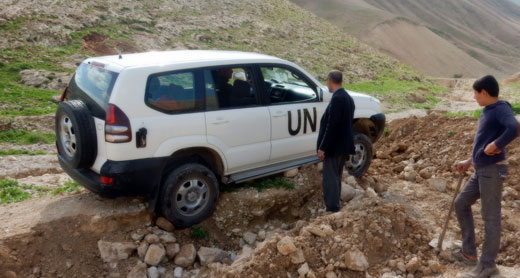
UN vehicle stuck on torn-up road leading to Khirbet ‘Ein al-Karzaliyah. Photo by ‘Aref Daraghmeh, B’Tselem, 10 Feb. 2016
Particularly prominent in this region were repeat demolitions in the communities of al-Mukasar and Khirbet ‘Ein al-Karzaliyah.
Khirbet ‘Ein al-Karzaliyah is a small shepherding community located about five kilometers south-west of the village of al-Jiftlik. Members of the community take their flocks and move to other parts of the Jordan Valley in spring and summer. On 10 February 2016, authorities demolished three tents that were home to 21 people, including ten minors, as well as ten livestock pens and enclosures. The demolitions took place less than a week after the authorities destroyed a tent, which has since been put back up. The military also razed the community’s access road, to prevent humanitarian aid from reaching the community, as it did last March. In 2014 and 2015, the Civil Administration demolished all structures in the community four different times.
On the same day, the military also came to the community of al-Mukasar, located between the Beka’ot military base and the settlement of Ro’i on one side and the al-Hamra checkpoint on the other. The troops once more demolished a tent which serves as a dwelling for a family of ten, including five minors, and a livestock pen. This demolition came less than a week after a previous demolition of the tent, which had since been erected anew. This is the third time since June 2015 that the military has demolished structures belonging to this and other al-Mukasar families. During this demolition, as well as in the previous one on 4 February 2016, authorities demolished and confiscated tents given to the family by humanitarian aid organizations.
Civil Administration bulldozer razing a livestock pen in al-Mkassar in the northern Jordan Valley. Photo: ‘Aref Daraghmeh, B’Tselem, 4 February 2016
In addition, between 9 and 11 February 2016, authorities also carried out demolitions in the communities Khillet al-Khader, al-Musafah and Abu al-‘Ajaj, located on the outskirts of the village of al-Jiftlik, as well as in Khirbet Tana and Fasayil al-Wusta, where they demolished once again the homes and livestock enclosure of a family whose structures had already been demolished in August 2015. The total number of demolitions in Jordan Valley communities over these three days stands at 22 dwellings and 35 structures used for storage and livestock. Authorities also demolished five structures in recognized villages in the Jordan Valley, built on village land designated as Area C.
On 21 January 2016, authorities demolished three huts used as a residence by a family in the community of Badu al-Mashru’, on the outskirts of the city of Jericho. The huts, donated by a humanitarian aid agency after a demolition in 2013, were used by a family of 13, including eight minors. In addition, on 14 January 2006, the Civil Administration demolished four structures used for storing farming equipment and grains in Khirbet ‘Einun, located about 5 kilometers from the Palestinian city of Tubas. On the same day in Khirbet ‘Einun, Civil Administration officials also destroyed a water reservoir which serves the community of Khirbet Yarza (through pipes), located some seven kilometers south-east of Tubas.
Ramallah Area
On 1 February 2016, authorities demolished the homes of three families in the community of ‘Ein Ayub in Deir ‘Ammar, 3 kilometers east of which the settlement of Na’ale was built. Troops demolished three residential tents which were home to 17 people, including 11 minors, and also a livestock pen belonging to one of the families.
On 14 January 2016, the authorities demolished a hut which was home to seven people, including three minors, and also two livestock pens, belonging to a family from the Ka’abneh tribe in one of the Bedouin communities east of the Palestinian village of a-Taybah, Ramallah District. The settlement of Kochav Hashachar was built near the community. This was also a repeat demolition; authorities had previously demolished the family’s home and other structures in the community on 3 September 2015.
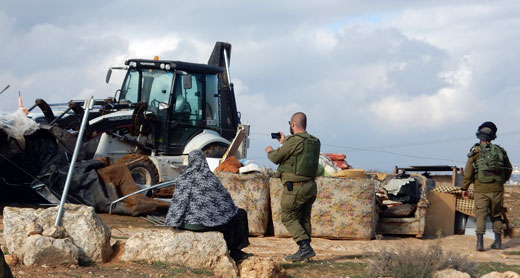
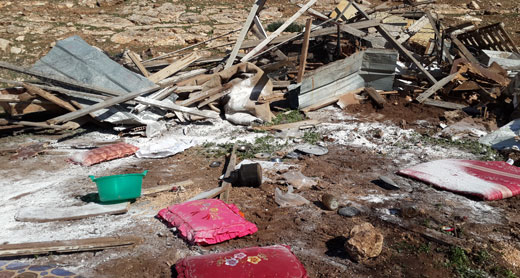
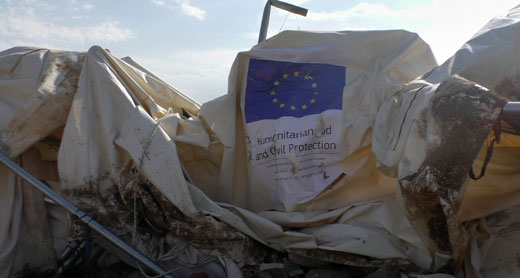

هیچ نظری موجود نیست:
ارسال یک نظر